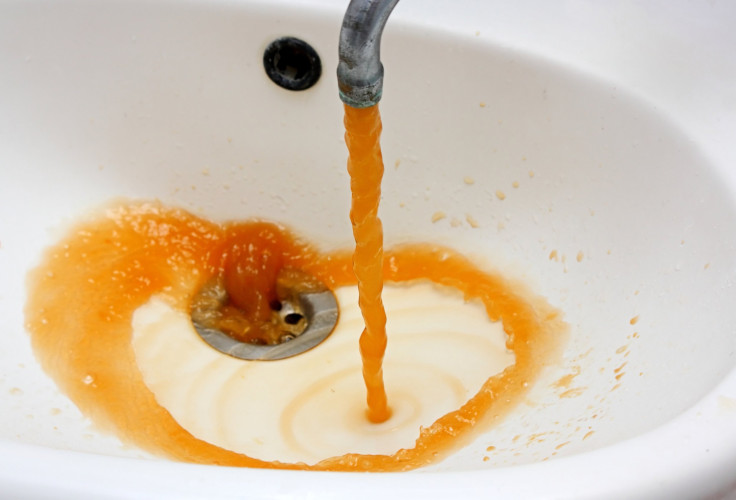Michigan Residents An Hour Away From Lake Huron Still Struggle To Find Clean Drinking Water

Last year, the city of Flint, Mich., broke away from the Detroit water system, and it hasn’t been able to tie down a clean water supply ever since. Residents of the financially struggling city continue to complain about the brown or yellow-colored water, which has left them with an array of health problems like itchy skin, rashes, headaches, and their hair falling out.
The plan to break away from Detroit’s water system was the city's attempt to save money. Now the city gets its water from the Flint River, at least for the time being — until a pipe to Lake Huron is completely constructed. And despite the fact that the city claims the water is fine, there have been several problems that are chafing residents, notably the taste and smell of the water, which is often brown/rusty and smells like chlorine, according to laments.
One resident, Tony Palladeno Jr., says he only buys bottled water to avoid the potential health problems of drinking the brownish, cloudy stuff that comes out of his faucet. He does, however, shower in it. “No matter what, if I go in [to the shower], one time it’s going to be my eyes, or I’ll get headaches or my lungs,” Palladeno told the AP. “People say, ‘Oh, it’s paranoia.’ No… I’m living with this.”
Another resident, Rick Holststander, says he doesn’t even allow his dog to drink the water.
On the City of Flint’s website, however, a recent post states that water tests showed the city’s water was well within EPA guidelines and was deemed safe to drink and bathe in. “Flint’s water supply is meeting all safety guidelines set forth by the EPA,” the Department of Public Works Director Howard Croft said. “We still have work to do to improve water quality and are committed to being vigilant to assure that water safety is maintained.”
Indeed, improvements may need to be bigger in scope than the city foresees. The water supply currently faces some challenges that may take some time to repair.
“Unfortunately, some of our problems aren’t quickly or easily solved,” Jerry Ambrose, the state-appointed emergency manager of the city, said, according to the NY Daily News. Some of the “challenges” they went through “were greater than we expected.” He continued: “The potential to leave [Detroit] was well-supported by a business case, and in the long-term will benefit this region as well as the city of Flint.”
Flint residents have certainly made their voices heard in protest of the water supply: through Facebook pages, council meetings, and protest marches downtown. Some churches and community organizers are giving away bottled water to those who are too scared to drink it from the tap.
What Makes Water Safe Or Unsafe To Drink?
The EPA has certain guidelines as to what constitutes safe water versus contaminated water. Under the Safe Drinking Water Act (SDWA), which was originally passed in 1974, the EPA must test and oversee states and water suppliers who are required to implement the water standards. The regulations account for limitations on levels of 90 different contaminants, including microorganisms, disinfectants, inorganic chemicals and organic chemicals — many of which can cause ailments, such as diarrhea, vomiting, pneumonia, and increased risks of cancer and other chronic disorders.
Water regulation is supposed to prevent these contaminants from entering your home through the faucet. But a recent report out of the Natural Resources Defense Council (NRDC) found that many U.S. cities suffer from substandard water quality — and residents are often kept out of the loop. It’s hard, besides, to find out exactly what’s in your glass of water when you don’t know where it’s coming from, whether the treatment it goes through is thorough, or whether your pipes are rusty. The NRDC states that in order for water to have good quality, the sources (lakes, streams, reservoirs, and wells) must be protected from pollution; the pipes carrying the water must be clean and well-maintained; and the water first goes through modern treatment facilities.
Perhaps the residents of Flint are pioneering awareness across the country about water safety (other cities with sub-par tap water include Atlanta, Albuqurque, San Francisco, and Fresno, according to the NRDC report. Many of these showed signs of water contaminated with lead, pathogens, and arsenic). The NRDC refers to “Right-to-Know” reports, which are required by federal law in states and cities that provide water. If a resident complains or asks what’s in the water, the water supplier must provide them with a “right-to-know” report. The problem is, a handful of delinquent cities and states with poor water quality standards may provide information that is misleading or incomplete. So when it comes to the residents of Flint their complaints should be heard and not dismissed as paranoia.



























